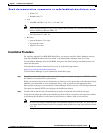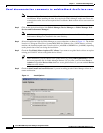
Send documentation comments to mdsfeedback-doc@cisco.com.
1-11
Cisco MDS 9000 Family Fabric Manager Configuration Guide
OL-6965-03, Cisco MDS SAN-OS Release 2.x
Chapter 1 Installation and Configuration
Integrating Cisco Fabric Manager with Other Management Tools
Note You can create users with management traffic encryption (so a Privacy password is required) or
no management traffic encryption (no Privacy password is required). Requiring a Privacy
password, and making it different from the authentication password, ensures stronger security
but may cause AAA problems.
Step 7 Check the Use SNMP Proxy check box if you want Fabric Manager client to communicate with Fabric
Manager Server through a TCP-based proxy server. See the “Fabric Manager Server Proxy Services”
section on page 1-2.
Note Accelerate Discovery check box should remain checked for normal operation. Uncheck this only
if you have changed switch IP addresses. You may experience problems with out of sync SAN
IDs in Fabric Manager if you uncheck this check box.
Step 8 Optionally, select the Local Interface for Fabric Manager client. In Fabric Manager Release 2.1(2) or
later, Fabric Manager automatically detect the correct interface to use.
Step 9 Click Open.
You see either the Fabric Manager or the Device Manager.
Note When logging into Fabric Manager or Device Manager, the local SNMP database is checked first. If no
username entry is found, the AAA database is checked.
Note If you have an incomplete view of your fabric, rediscover the fabric with a user that has a network
administrator or network operator role.
Integrating Cisco Fabric Manager with Other Management
Tools
You can use Fabric Manager, Device Manager, and Performance Manager with other management tools.
Here is a brief description of these tools. For more information on these tools and how they work together
with the Cisco Fabric Manager management applications, see Chapter 35, “Troubleshooting Your
Fabric,”
• Cisco Traffic Analyzer—Allows you to break down traffic by VSANs and protocols and to examine
SCSI traffic at a logical unit number (LUN) level.
• Cisco Protocol Analyzer—Enables you to examine actual sequences of Fibre Channel frames easily
using the Fibre Channel and SCSI decoders Cisco developed for Ethereal.
• Cisco Port Analyzer Adapter 2—Encapsulates SPAN traffic (both Fibre Channel control and data
plane traffic) in an Ethernet header for transport to a Windows PC or workstation for analysis. Both
the Cisco Traffic Analyzer and Cisco Protocol Analyzer required the PAA to transport MDS SPAN
traffic to a Windows PC or workstation.


















